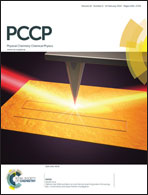Size dependent structural relaxations and dielectric properties induced by surface functionalized MWNTs in poly(vinylidene fluoride)/poly(methyl methacrylate) blends
Abstract
Structural dynamics, dielectric permittivity and ferroelectric properties in poly(vinylidene fluoride) (PVDF)/poly(methyl methacrylate) (PMMA) (PVDF/PMMA) blends with respect to crystalline morphology was systematically investigated in presence of amine functionalized MWNTs (NH2-MWNTs) using dielectric spectroscopy. The crystalline morphology and the crystallization driven demixing in the blends was assessed by light microscopy (LM), wide angle X-ray diffraction (WXRD) and, in situ, by shear rheology. The crystal nucleation activity of PVDF was greatly induced by NH2-MWNTs, which also showed two distinct structural relaxations in dielectric loss owing to mobility confinement of PVDF chains and smaller cooperative lengths. The presence of crystal–amorphous interphase was supported by the presence of interfacial polarization at lower frequencies in the dielectric loss spectra. On contrary, the control blends showed a single broad relaxation at higher frequency due to defective crystal nuclei. This was further supported by monitoring the dielectric relaxations during isothermal crystallization of PVDF in the blends. These observations were addressed with respect to the spherulite sizes which were observed to be larger in case of blends with NH2-MWNTs. Higher dielectric permittivity with minimal losses was also observed in blends with NH2-MWNTs as compared to neat PVDF. Polarization obtained using P–E (polarization–electric field) hysteresis loops was higher in case of blends with NH2-MWNTs in contrast to control blends and PVDF. These observations were corroborated with the charge trapped at the crystal–amorphous interphase and larger crystal sizes in the blends with NH2-MWNTs. The microstructure and localization of MWNTs were assessed using SEM.


 Please wait while we load your content...
Please wait while we load your content...